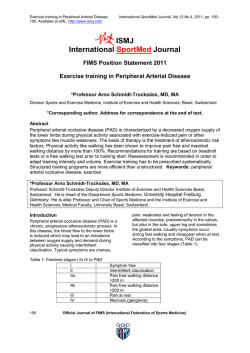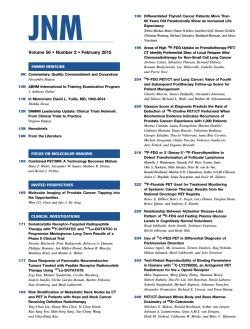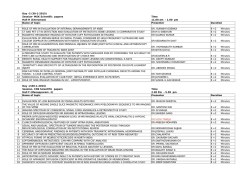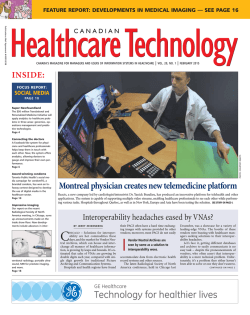
Dr. SriniVas Sadda
Applications of Wide-field Imaging SriniVas • Research Grant Recipient: Allergan, Genentech, Carl Zeiss Meditec, Optovue, Optos Sadda, MD Professor of Ophthalmology Director, Medical Retina Unit Ophthalmic Imaging Unit Doheny Image Reading Center Doheny Eye Institute David Geffen School of Medicine University of California – Los Angeles Disclosure • Consultant: Allergan, Genentech, Regeneron, Carl Zeiss Meditec, Optos RETINAL UPDATE 2015 January 31, 2015 What is widefield imaging? • DSMC: e-ROP study (NEI) Technology for multimodal widefield imaging Optomap P200Tx Ø Multi-wavelength Scanning Laser Ophthalmoscope Widefield • Red (633), green (532), and blue (488) Scanning Lasers • Virtual Point™ SLO Technology 50 degree mode Traditional Fundus Camera – Optical path allows images to be captured from a point that is “virtually” in the eye Ø Permits “color”, FA, and autoflourescence Ø Scans up to 200° of the Retina Ø Image capture in 0.25 seconds DRCR.net definition: Widefield = >100 degrees Ø Non-mydriatic colour and AF imaging (> 2.0mm pupil size) Technology for multimodal widefield imaging Technology for multimodal widefield imaging • Heidelberg non-contact widefield angiography module • Staurenghi contact widefield lens – 150 degrees – ?100 degrees Clinical Ophthalmology Dovepress open access to scientific and medical research ORIGINAL RESEARCH Open Access Full Text Article Comparison of ultra-widefield fluorescein angiography with the Heidelberg Spectralis® noncontact ultra-widefield module versus the Optos® Optomap® Matthew T Witmer George Parlitsis Sarju Patel Szilárd Kiss Department of Ophthalmology, Weill Cornell Medical College, New York, NY, USA Correspondence: Szilárd Kiss; Matthew T Witmer Weill Cornell Medical College, Department of Ophthalmology, 1305 York Ave, 11th Floor, New York, NY 10021, USA Tel 1 646 962 2020 Fax 1 646 962 0602 Email [email protected]; [email protected] submit your manuscript | www.dovepress.com Dovepress http://dx.doi.org/10.2147/OPTH.S41731 Purpose: To compare ultra-widefield fluorescein angiography imaging using the Optos® Optomap® and the Heidelberg Spectralis® noncontact ultra-widefield module. Methods: Five patients (ten eyes) underwent ultra-widefield fluorescein angiography using the Optos® panoramic P200Tx imaging system and the noncontact ultra-widefield module in the Heidelberg Spectralis® HRAOCT system. The images were obtained as a single, nonsteered shot centered on the macula. The area of imaged retina was outlined and quantified using Adobe® Photoshop® C5 software. The total area and area within each of four visualized quadrants was calculated and compared between the two imaging modalities. Three masked reviewers also evaluated each quadrant per eye (40 total quadrants) to determine which modality imaged the retinal vasculature most peripherally. Results: Optos® imaging captured a total retinal area averaging 151,362 pixels, ranging from 116,998 to 205,833 pixels, while the area captured using the Heidelberg Spectralis® was 101,786 pixels, ranging from 73,424 to 116,319 (P 0.0002). The average area per individual quadrant imaged by Optos® versus the Heidelberg Spectralis® superiorly was 32,373 vs 32,789 pixels, respectively (P 0.91), inferiorly was 24,665 vs 26,117 pixels, respectively (P 0.71), temporally was 47,948 vs 20,645 pixels, respectively (P 0.0001), and nasally was 46,374 vs 22,234 pixels, respectively (P 0.0001). The Heidelberg Spectralis® was able to image the superior and inferior retinal vasculature to a more distal point than was the Optos®, in nine of ten eyes (18 of 20 quadrants). The Optos® was able to image the nasal and temporal retinal vasculature to a more distal point than was the Heidelberg Spectralis®, in ten of ten eyes (20 of 20 quadrants). Conclusion: The ultra-widefield fluorescein angiography obtained with the Optos® and Heidelberg Spectralis® ultra-widefield imaging systems are both excellent modalities that provide views of the peripheral retina. On a single nonsteered image, the Optos® Optomap® covered a significantly larger total retinal surface area, with greater image variability, than did the Heidelberg Spectralis® ultra-widefield module. The Optos® captured an appreciably wider view of the retina temporally and nasally, albeit with peripheral distortion, while the ultra-widefield Heidelberg Spectralis® module was able to image the superior and inferior retinal vasculature more peripherally. The clinical significance of these findings as well as the area imaged on steered montaged images remains to be determined. Keywords: peripheral, retina, wide-angle, widefield, ultra-widefield Introduction As the site of considerable pathology, visualization of the peripheral retina has become essential to the screening, diagnosis, monitoring, and treatment of many visionthreatening eye diseases, including diabetic retinopathy. Clinical Ophthalmology 2013:7 389–394 389 © 2013 Witmer et al, publisher and licensee Dove Medical Press Ltd. This is an Open Access article which permits unrestricted noncommercial use, provided the original work is properly cited. From http://www.revophth.com/content/d/retina/c/35992/` 1 Technology for multimodal widefield imaging Applications of widefield imaging Other contact methods (100-120 degrees) Panoret 1000 RetCam 3 • Angiography • Color Transcleral illumination • Autofluorescence Applications of widefield imaging • Angiography Applications of widefield imaging • Angiography – Peripheral Neovascularization – Peripheral Neovascularization – Peripheral Non-perfusion – Peripheral Non-perfusion – Peripheral Vasculitis – Peripheral Vasculitis Why widefield angiography? Why widefield angiography? ETDRS: 7 Standard Fields Traditional Photography: 30 Degrees • Still only a relatively small portion of the retina is sampled • Is this enough for managing this patient? Image courtesy of Szilárd Kiss, MD Image courtesy of Szilárd Kiss, MD 2 Why widefield angiography? Ultra-widefield FA (Optos) ETDRS: 7 Standard Fields Why widefield angiography? ETDRS: 7 Standard Fields • Is this an unusual case? • How frequently are we understaging diabetic retinopathy or potentially missing lesions that would affect management? Image courtesy of Szilárd Kiss, MD Clinical importance of widefield imaging for diabetic retinopathy Kiss et al, Retina 2011 Clinical importance of widefield imaging for diabetic retinopathy Kiss et al, Retina 2011 Retrospective review of diabetic patients who underwent diagnostic Optos UW fluorescein angiography • UWFA showed 3.2X more total retinal surface area than 7SF. • Compared to 7SF, UWFA also showed: – 3.9x more nonperfusion (p<0.001) – 1.9x more NV (p=0.036) The respective areas identified on UWFA were compared to a modified ETDRS 7SF image as – 3.8x more PRP (p=0.001) • In 22 eyes (10%), UWFA demonstrated retinal pathology (including nonperfusion (n=13) and neovascularization (n=9)) not evident in an 7SF overly. 218 eyes of 118 diabetic patients were included. Clinical importance of widefield imaging for diabetic retinpathy Kiss et al, Retina 2011 Image courtesy of Szilárd Kiss, MD Several distinct patterns observed Case: Peripheral PDR Asymptomatic 64 y/o HM for routine DM2 exam: 20/25 OU Peripheral Non-perfusion and NV 3 Clinical importance of widefield imaging for diabetic retinopathy Case: Peripheral PDR Asymptomatic 64 y/o HM for routine DM2 exam: 20/25 OU Several distinct patterns observed Kiss et al, Retina 2011 Peripheral Retina Relatively Spared Clinical importance of widefield imaging for diabetic retinopathy Several distinct patterns observed Kiss et al, Retina 2011 Clinical importance of widefield imaging for diabetic retinopathy Kiss et al, Retina 2011 Conclusions: Peripheral Ischemia, mid-peripheral NV Benefits of widefield angiography • Flourescein Angiography Compared to conventional imaging, UWFA demonstrates significantly more pathology in patients with diabetic retinopathy. Improved visualization can alter the classification of retinopathy; may influence follow-up and treatment of these patients. Clinical significance - targeted peripheral treatment and effect of anti-VEGF therapy - currently under investigation for both diabetic retinopathy and venous occlusive disease. Upcoming DRCR.net protocols Benefits of widefield angiography • Flourescein Angiography – Peripheral Neovascularization – Peripheral Neovascularization – Peripheral Non-perfusion – Peripheral Non-perfusion – Peripheral Vasculitis – Peripheral Vasculitis 4 Case: Re(nal Vein Occlusion Case: Re(nal Vein Occlusion 52 y/o Diabe(c F w/ glaucoma presents with rapid loss of superior visual field ↓ vision OS and NVI Diagnosis: HRVO, background DR Patient needs PRP (+/- anti-VEGF), but do they need an FA? Widefield imaging for venous occlusive disease Tsui et al, • Developed an ischemic index (ISI), based on the percent of retina that was non-perfused on UWFA. • ISI was correlated with development of anterior and posterior segment NV. • Mean ISI in eves with NV was 75% compared with 6% in eyes without NV. • Ischemic index was significantly correlated to neovascularization (P <0.0001). Clinical importance of widefield imaging for macular edema Kiss et al, BJO 2012 Case: Venous Occlusive Disease 67 y/o HF with BRVO OS; Va = 20/80 CME NVI Tx’d with anti-VEGF + PRP Studied relationship between peripheral ischemia and presence of DME Patients with peripheral retinal ischemia had a 3.75 times increased odds of having macular compared to those without retinal ischemia (p<0.02). Clinical significance - targeted peripheral treatment for persistent macular edema (e.g. in patients undergoing anti-VEGF therapy) is currently under investigation for eyes with retinal vascular disease Case: Venous Occlusive Disease 67 y/o HF with BRVO OS; After PRP à NVI resolved Despite 8 monthly anti-VEGF injections and grid laser…. VMT resolved, CME improved but persisted (Va=20/60) Is VMT a concern here? 5 Case: Venous Occlusive Disease 67 y/o HF with BRVO OS; After PRP à NVI resolved Despite 8 monthly anti-VEGF injections and grid laser…. CME improved but persisted (Va=20/60) Case: Venous Occlusive Disease 67 y/o HF with BRVO OS; After supplemental PRP 1 month later Edema further reduced, Va = 20/30 PRP added through this area of non-perfusion Applications of widefield imaging • Angiography Applications of widefield imaging • Angiography – Peripheral Neovascularization – Peripheral Neovascularization – Peripheral Non-perfusion – Peripheral Non-perfusion – Peripheral Vasculitis – Peripheral Vasculitis Case 62 y/o Asian Female: complained of some “fogginess” of peripheral vision in both eyes, Va =20/25 OU Case 62 y/o Asian Female: complained of some “fogginess” of peripheral vision in both eyes, Va =20/25 OU20/25 OU Dx: Peripheral Vasculi(s OU (only OD shown) Labs: ANA+ 1: 160 (Speckled) Follow-‐up: mixed connec(ve (ssue disease 6 Next evolution of widefield angiography Ultrawidefield ICGA Optos ICG prototype Central Serous Chorioretinopathy Advanced Choroidal Neovascularization Courtesy: K. Bailey Freund Case Ultrawidefield ICGA Polypoidal Choroidal Vasculopathy Courtesy: K. Bailey Freund Applications of widefield imaging 67 y/o CF with flashing lights and floaters OD Va: 20/20 OU + occludable angles Mio(c pupils: limited view Does pa(ent need an urgent PI? Image captured through undilated pupil Dx: Macula-on RD with multiple breaks Applications of widefield imaging • Angiography • Angiography • Color • Color • Autofluorescence Answer: Yes – Visualization through small pupils or media opacity 7 Applications of widefield imaging • Angiography 74 y/o CM with poor vision OU for his whole life LP HM • Color – Visualization through small pupils or media opacity – Long Axial Length Diagnosis: Pathologic myopia with deep staphyloma (axial length: 33mm) Virtual Point Benefit: Note base of staphyloma and peripheral retina are both in focus à due to large depth of field Applications of widefield imaging Applications of widefield imaging • Angiography • Angiography • Color • Color – Visualization through small pupils or media opacity – Long Axial Length Documentation of DR severity – Visualization through small pupils or media opacity – Long Axial Length – Documentation Predominantly Peripheral Lesions Aiello et al, Joslin Diabetes Center Peripheral Lesions Identified by Mydriatic Ultrawide Field Imaging: Distribution and Potential Impact on Diabetic Retinopathy Severity Paolo S. Silva, MD,1,2 Jerry D. Cavallerano, OD, PhD,1,2 Jennifer K. Sun, MD, MPH,1,2 Ahmed Z. Soliman, MD,1,2 Lloyd M. Aiello, MD,1,2 Lloyd Paul Aiello, MD, PhD1,2 Objective: To assess diabetic retinopathy (DR) as determined by lesions identified using mydriatic ultrawide field imaging (DiSLO200; Optos plc, Scotland, UK) compared with Early Treatment Diabetic Retinopathy Study (ETDRS) 7-standard field film photography. Design: Prospective comparative study of DiSLO200, ETDRS 7-standard field film photographs, and dilated fundus examination (DFE). Participants: A total of 206 eyes of 103 diabetic patients selected to represent all levels of DR. Methods: Subjects had DiSLO200, ETDRS 7-standard field film photographs, and DFE. Images were graded for severity and distribution of DR lesions. Discrepancies were adjudicated, and images were compared side by side. Main Outcome Measures: Distribution of hemorrhage and/or microaneurysm (H/Ma), venous beading (VB), intraretinal microvascular abnormality (IRMA), and new vessels elsewhere (NVE). Kappa (k) and weighted k statistics for agreement. Results: The distribution of DR severity by ETDRS 7-standard field film photographs was no DR 12.5%; nonproliferative DR mild 22.5%, moderate 30%, and severe/very severe 8%; and proliferative DR 27%. Diabetic retinopathy severity between DiSLO200 and ETDRS film photographs matched in 80% of eyes (weighted k ¼ 0.74,k ¼ 0.84) and was within 1 level in 94.5% of eyes. DiSLO200 and DFE matched in 58.8% of eyes (weighted k ¼ 0.69,k ¼ 0.47) and were within 1 level in 91.2% of eyes. Forty eyes (20%) had DR severity discrepancies between DiSLO200 and ETDRS film photographs. The retinal lesions causing discrepancies were H/Ma 52%, IRMA 26%, NVE 17%, and VB 4%. Approximately one-third of H/Ma, IRMA, and NVE were predominantly outside ETDRS fields. Lesions identified on DiSLO200 but not ETDRS film photographs suggested a more severe DR level in 10% of eyes. Distribution in the temporal, superotemporal, inferotemporal, superonasal, and inferonasal fields was 77%, 72%, 61%, 65%, and 59% for H/Ma, respectively (P < 0.0001); 22%, 24%, 21%, 28%, and 22% for VB, respectively (P ¼ 0.009); 52%, 40%, 29%, 47%, and 36% for IRMA, respectively (P < 0.0001), and 8%, 4%, 4%, 8%, and 5% for NVE, respectively (P ¼ 0.03). All lesions were more frequent in the temporal fields compared with the nasal fields (P < 0.0001). Conclusions: DiSLO200 images had substantial agreement with ETDRS film photographs and DFE in determining DR severity. On the basis of DiSLO200 images, significant nonuniform distribution of DR lesions was evident across the retina. The additional peripheral lesions identified by DiSLO200 in this cohort suggested a more severe assessment of DR in 10% of eyes than was suggested by the lesions within the ETDRS fields. However, the implications of peripheral lesions on DR progression within a specific ETDRS severity level over time are unknown and need to be evaluated prospectively. Financial Disclosure(s): Proprietary or commercial disclosure may be found after the references. Ophthalmology 2013;120:2587e2595 ª 2013 by the American Academy of Ophthalmology. Management of diabetic eye disease is guided by landmark clinical trials conducted during the past 40 years.1e10 These clinical trials established treatment modalities and elucidated the risk for progression, visual loss, and response to treatment on the basis of the severity level of diabetic retinopathy (DR). In these trials, DR was evaluated using ! 2013 by the American Academy of Ophthalmology Published by Elsevier Inc. • Non-mydriatic Optos images have excellent agreement with dilated ETDRS photos and dilated fundus examination in determining severity of DR and DME. mydriatic stereoscopic 30-degree 35-mm retinal photography obtained using a defined protocol of 7-standard retinal fields in what is referred to as “Early Treatment Diabetic Retinopathy Study (ETDRS) protocol fundus photography.” This method of retinal evaluation has been widely adopted and has generally remained the gold standard for evaluation ISSN 0161-6420/13/$ - see front matter http://dx.doi.org/10.1016/j.ophtha.2013.05.004 2587 10% of time peripheral lesions suggested a more severe assessment than EDTRS 7 fields Any HMA, IRMA or NVE distributed >60% outside ETDRS fields 8 Aiello et al, Joslin Diabetes Center Aiello et al, Joslin Diabetes Center Key Study Question • To determine if the distribution of DR lesions outside as compared to within the ETDRS 7 standard fields is associated with differences in DR progression over 4 years. • Study approach: – ETDRS photos at baseline to determine baseline DR severity – UWF imaging at baseline to assess baseline posterior and peripheral lesion distribution – ETDRS photos ~4 years later to assess DR severity change Posterior vs Peripheral Lesions • Total eyes = 109 • Eyes with any predominantly peripheral lesion type • 55 (50%) • Eyes without a predominantly peripheral lesion type • 54 (50%) – Compare DR severity change by posterior and peripheral lesion distribution at baseline Predominantly peripheral retinopathy in diabetes Aiello et al, Joslin Diabetes Center Baseline Peripheral Lesion Effect on PDR Onset at 4 Years in Eyes with No DR or NPDR at Baseline (by ETDRS photos at baseline and followup, N=109) PDR Onset Eyes WITHOUT Predominantly Peripheral Lesions at baseline (N=54) Eyes WITH Predominantly Peripheral Lesions at baseline (N=55) Yes 6% (3) 4.2 fold increased risk 25% (14) P value* P value† 0.0069 0.0816 Implications • If these findings are confirmed in larger trials across each DR severity group, careful peripheral retinal evaluation or peripheral imaging may become essential in clinical, research and teleophthalmology settings to more accurately determine risk of DR progression. 2 year average HbA1c prior to baseline*Fisher’s exact test †Corrected for baseline DR severity, diabetes duration, diabetes type and Applications of widefield imaging ARIA Assessing diabetic RetInopAthy Study Objectives: Ø Longitudinal Prediction of Progression: Patients will be followed for 5 years to determine the predictive factor of peripheral lesions on the progression of diabetic eye disease. Ø Will look to confirm/corroborate results of the Joslin ETDRS 7 standard field validation study Ø 40 sites Ø n= 350, FPI – Winter 2014 • Angiography • Color – Visualization through small pupils or media opacity – Long Axial Length – Documentation – Retinopathy screening 53 9 New gold standard for diabetic retinopathy telescreening Remote ROP screening Research Original Investigation Validity of a Telemedicine System for the Evaluation of Acute-Phase Retinopathy of Prematurity Graham E. Quinn, MD, MSCE; Gui-shuang Ying, PhD; Ebenezer Daniel, MBBS, MS, PhD; P. Lloyd Hildebrand, MD; Anna Ells, MD, FRCS; Agnieshka Baumritter, MS; Alex R. Kemper, MD, MPH, MS; Eleanor B. Schron, PhD, RN; Kelly Wade, MD, PhD, MSCE; for the e-ROP Cooperative Group IMPORTANCE The present strategy to identify infants needing treatment for retinopathy of prematurity (ROP) requires repeated examinations of at-risk infants by physicians. However, less than 10% ultimately require treatment. Retinal imaging by nonphysicians with remote image interpretation by nonphysicians may provide a more efficient strategy. Supplemental content at jamaophthalmology.com OBJECTIVE To evaluate the validity of a telemedicine system to identify infants who have sufficiently severe ROP to require evaluation by an ophthalmologist. DESIGN, SETTING, AND PARTICIPANTS An observational study of premature infants starting at 32 weeks’ postmenstrual age was conducted. This study involved 1257 infants with birth weight less than 1251 g in neonatal intensive care units in 13 North American centers enrolled from May 25, 2011, through October 31, 2013. INTERVENTIONS Infants underwent regularly scheduled diagnostic examinations by an ophthalmologist and digital imaging by nonphysician staff using a wide-field digital camera. Ophthalmologists documented findings consistent with referral-warranted (RW) ROP (ie, zone I ROP, stage 3 ROP or worse, or plus disease). A standard 6-image set per eye was sent to a central server and graded by 2 trained, masked, nonphysician readers. A reading supervisor adjudicated disagreements. • Assessment of diabetic retinopathy severity from non-myd UWF images showed excellent agreement with gold standard screening methods MAIN OUTCOMES AND MEASURES The validity of grading retinal image sets was based on the sensitivity and specificity for detecting RW-ROP compared with the criterion standard diagnostic examination. RESULTS A total of 1257 infants (mean birth weight, 864 g; mean gestational age, 27 weeks) underwent a median of 3 sessions of examinations and imaging. Diagnostic examination identified characteristics of RW-ROP in 18.2% of eyes (19.4% of infants). Remote grading of images of an eye at a single session had sensitivity of 81.9% (95% CI, 77.4-85.6) and specificity of 90.1% (95% CI, 87.9-91.8). When both eyes were considered for the presence of RW-ROP, as would routinely be done in a screening, the sensitivity was 90.0% (95% CI, 85.4-93.5), with specificity of 87.0% (95% CI, 84.0-89.5), negative predictive value of 97.3%, and positive predictive value of 62.5% at the observed RW-ROP rate of 19.4%. • Lower rate of ungradable images compared to conventional photographic screening Retcam 3 CONCLUSIONS AND RELEVANCE When compared with the criterion standard diagnostic examination, these results provide strong support for the validity of remote evaluation by trained nonphysician readers of digital retinal images taken by trained nonphysician imagers from infants at risk for RW-ROP. TRIAL REGISTRATION clinicaltrials.gov Identifier: NCT01264276 • Media opacity benefits JAMA Ophthalmol. doi:10.1001/jamaophthalmol.2014.1604 Published online June 26, 2014. Author Affiliations: Author affiliations are listed at the end of this article. Group Information: The e-ROP Cooperative Group members are listed at the end of the article. Corresponding Author: Graham E. Quinn, MD, MSCE, Division of Ophthalmology, The Children’s Hospital of Philadelphia, Wood Center, 1st Floor, Philadelphia, PA 19104 ([email protected]). E1 Copyright 2014 American Medical Association. All rights reserved. Downloaded From: http://archopht.jamanetwork.com/ by a University of California - Los Angeles User on 07/29/2014 Non-contact ultra-widefield imaging of ROP CK Patel et al 592 Table 1 Clinical characteristics of the ROP cases GA BW PNA Case (weeks) (g) (weeks) Race Sex 24 25 785 590 34 70 Caucasian M Mixed race M 3 4 5 30 24 27 1540 755 1045 34 46 38 Caucasian M Mixed race F Caucasian F 6 27 1150 34 Asian 7 8 9 24 23 28 550 590 1120 43 42 351 M Caucasian F Mixed race F Caucasian F APROP S3, Z1 Pre-plus S1, Z3 S2, Z2 S3, Z2 Pre-plus S3, Z2 Plus S4b S4a, Z2 S3, Z1 APROP S3, Z1 Pre-plus No ROP S2, Z2 S3, Z2 Pre-plus S3, Z2 Plus S4a S4a, Z2 S3, Z1 imaging of ROP 591 Applications of widefield imaging Remote ROP screening Abbreviations: BW, birth weight; F, female; GA, gestational age; M, male; PNA, postnatal age; S1–S5, stages 1–5; Z1–Z3, zones 1–3 and plus disease according to the ICROP classification of ROP. respectively (Figures 3e and f). The left eye had skip areas nasally that were treated with additional laser, and the right eye was managed conservatively. NC-UWFI in the right eye showed fibrous tissue associated with a tractional retinal detachment involving the macula (white arrows in Figure 3e), with the optic disc indicated by the yellow arrow in Figure 3e. There was a peripheral retinal detachment seen inferotemporally in the left eye, which is not convincingly visualised in the Optos image. “flying baby position” Case 8: Stage-4a ROP in zone 2 A baby was referred after developing bilateral, threshold ROP in zone 2 (Figure 4a). Confluent bilateral laser photocoagulation was performed at 39 weeks PNA and the baby discharged for ophthalmic review elsewhere. She developed bilateral stage-4a retinal detachment and a heavy circumferential cicatrix 5 weeks later. The baby was re-admitted to our hospital, and treated with bilateral encirclement and left-sided lens sparing vitrectomy. The NC-UWFI from the left eye shows a double ridge of stage 3 before laser treatment (Figure 4a; white arrows). Following initial laser treatment, cicatrisation of the ridge developed, with a subsequent extra-foveal retinal detachment in the infero-temporal quadrant (Figure 4b; blue arrow). Lens-sparing vitrectomy to partially release traction has resulted in the resolution of retinal detachment, and it is possible to visualise the residual circular cicatrix that required support with an encircling band (Figure 4c). Fast Track Paper Eye (2013) 27, 589–596 & 2013 Macmillan Publishers Limited All rights reserved 0950-222X/13 www.nature.com/eye Non-contact ultra-widefield imaging of retinopathy of prematurity using the Optos dual wavelength scanning laser ophthalmoscope Abstract CK Patel1 , THM Fung1 , MMK Muqit1 , DJ Mordant1 , J Brett1 , L Smith1 and E Adams2 CLINICAL STUDY 1 2 Non-contact ultra-widefield Grade (S1–S5) Grade (S1–S5) Zone (Z1–Z3) Zoneet (Z1–Z3) CK Patel al Right eye Left eye • Color Optos Aims The purpose of this report is to demonstrate that a non-contact ultrawidefield dual wavelength laser camera (Optos) is able to capture high-quality images in retinopathy of prematurity (ROP). Materials and methods We conducted a retrospective review of patients attending the Oxford Eye Hospital with ROP between 1 August 2012 and 16 November 2012 that underwent standard clinical assessment. Anterior segment imaging, where relevant, was performed with Retcam. Retinal imaging was then performed with Optos, using a modified ‘flying baby position’. Results The Optos scanning laser ophthalmoscope was able to acquire ultra-widefield fundal images in nine ROP subjects. The images obtained show clear views of the different stages of ROP features at the posterior pole and peripheral retina. Regression of ROP features were identified, following laser and intravitreal bevacizumab treatment. Additionally, ‘skip areas’ missed by initial laser treatment could be identified in the peripheral retina. Conclusion The Optos ultra-widefield scanning laser ophthalmoscope is capable of acquiring clinically useful high-quality images of the fundus in ROP subjects. The imaging technique could potentially be used in monitoring ROP progression and documenting ROP regression following treatment. Eye (2013) 27, 589–596; doi:10.1038/eye.2013.45; published online 22 March 2013 Keywords: retinopathy of prematurity; ultra-widefield imaging; Optos Introduction Our centre uses Retcam (Clarity Medical Systems, Pleasanton, CA, USA) to monitor objectively the response to laser treatment of advanced retinopathy of prematurity (ROP) that is identified by indirect ophthalmoscopy during screening. Retcam imaging is useful for teaching and permits the detection of ‘skip areas’, which can be dealt with as a top-up treatment. As Retcam requires contact with the eye, we became concerned about increased infection risk when using it in the early postoperative period, following intravitreal injection of bevacizumab (Avastin; Roche, Grenzach, Germany) for high-risk posterior ROP.1 We had successfully obtained an oral fluorescein angiogram using a non-contact ultra-widefield scanning laser ophthalmoscope system in an infant referred for the management of incontinentia pigmenti and decided to use the ophthalmoscope to monitor the therapeutic response to intravitreal injection of bevacizumab.2 We felt that the quality of noncontact ultra-widefield imaging (NC-UWFI) was superior to Retcam in many ways. On the 1 Paediatric Vitreoretinal Service, Oxford Eye Hospital, John Radcliffe Hospital, Oxford, UK • Autofluorescence 2 Neonatal Unit, John Radcliffe Hospital, Oxford, UK Correspondence: CK Patel, Oxford Eye Hospital, John Radcliffe Hospital, Oxford OX3 9DU, UK. Tel: þ 44 (0)1865 741166; Fax: þ 44 (0)1865 234515. E-mail: ckpatel@ btinternet.com Received: 22 November 2012 Accepted in revised form: 28 February 2013 Published online: 22 March 2013 Applications of widefield imaging • Angiography • Angiography Frequency of peripheral FAF abnormalities in retinal disease Figure 2 (a) Pseudo-colour fundal Optos image of a baby’s right eye with stage 1, zone-3 ROP (white arrows). (b) Pseudo-colour fundal Optos image of a baby’s right eye with stage 2, zone-2 ROP (white arrows). (c) Pseudo-colour fundal Optos image of a baby’s left with stage 3, zone-2 ROP and multifocal retinal haemorrhages. Extra-retinal neovascularisation was seen (white arrows). • Consecutive series of patients referred to the Doheny/USC imaging unit for FAF imaging lens-sparing vitrectomies and encirclement with silicone oil tamponade as a baby. Further surgery involved division of the buckle and removal of oil for a stage-4b • Both 30 degree and UWF FAF images were obtained Case 9: Treated stage-3 ROP in zone 1 • Color A pseudo-colour fundal image of the left eye has been acquired through small bound-down pupil (Figure 4d) and cataract at 7 years of age. The child had had two Eye • Autofluorescence • Graded for presence of FAF abornmalities outside posterior pole ‘flying baby position’. (b) Pseudo-colour fundal Optos images of a CPAP baby’s right eye with APROP before inent plus disease with circumferential neovascular proliferation in zone 1 (white arrows) was noted. The arrow). (c) Pseudo-colour fundal Optos images of a CPAP baby’s right eye with APROP after Avastin injection: isease was noted (d, e). Pseudo-colour fundal Optos images of a baby with resolved stage 3, zone-1 ROP. e right eye and zone 3 of the left eye was noted (white arrows). hages. NC-UWFI of the left eye 3 ROP with pre-plus disease, w. The extra-retinal neovascularisation white arrows in Figure 2c. in zone 2 with plus disease the retinal images (Figure 3a). Diode laser treatment was applied to both eyes, and we recorded the disease activity 1 week later (Figures 3c and d). Skip areas were seen supero-temporally in the right eye (yellow arrows in Figure 3c). The plus disease had however improved bilaterally. 10 Frequency of peripheral FAF abnormalities in retinal disease • A total of 461 eyes of 248 patients consecutive patients in a tertiary care retina practice undergoing FAF imaging Heussen et al, IOVS, 2012 Disease Number of Eyes Age-related macular degeneration Inflammatory Degenerations • Atrophy OU, fibrosis OS, % of Eyes with Peripheral FAF Abnormalities 79% Number with Abnormal Peripheral FAF (%) Age-related macular degeneration 134 106 (79%) Central serous chorioretinopathy 17 9 (53%) Ocular tumors 11 9 (82%) Inflammatory/infectious diseases 104 74 (71%) Retinal degenerations 90 74 (82%) Miscellaneous (diabetic retinopathy, 105 47 (44%) ALL 461 319 (69%) retinal vascular occlusive disease, ocular albinoidism, non-specific pigmentary changes) AMD CSCR Ocular tumors Patterns of peripheral FAF in AMD Patterns of peripheral FAF in AMD Normal periphery Granular increased • Characteristic feature: foci of increased FAF • “Color” correlate: drusen Patterns of Peripheral FAF in AMD Pattern Nonneovascular AMD (%) Neovascular AMD (%) Normal 27.2 14.0 Granular 51.8 52.3 Nummular 17.5 24.4 Mottled 34.2 48.8 Case 70 y/o Vietnamese male with ↓ vision OU x2Y 20/400 OU PMHx: Asthma, o/w negative “Granular Increased FAF” • 100 consecutive AMD patients: Presence of any abnormal FAF: – Neovascular vs. Non-neovascular AMD: 86.0% vs. 72.8% (p=0.025) “Mottled Decreased FAF” “Nummular Decreased FAF” 11 Case 70 y/o Vietnamese male with ↓ vision OU x2Y 20/400 OU PMHx: Asthma, o/w negative Case 70 y/o Vietnamese male with ↓ vision OU x2Y 20/400 OU PMHx: Asthma, o/w negative Case 70 y/o Vietnamese male with ↓ vision OU x2Y 20/400 OU PMHx: Asthma, o/w negative AMD AMD CSCR Ocular tumors Inflammatory Case 70 y/o Vietnamese male with ↓ vision OU x2Y 20/400 OU PMHx: Asthma, o/w negative CSCR Central Serous Chorioretinopathy Degenerations • Punctate areas of decreased FAF with broad patches of increased FAF (corresponding to old neurosensory detachment) Ocular tumors Inflammatory Central Serous Chorioretinopathy Degenerations % of Eyes with Peripheral FAF Abnormalities 53% • Full extent of gutters extending from the macula may be defined % of Eyes with Peripheral FAF Abnormalities 53% 12 AMD AMD CSCR CSCR Ocular Tumors Ocular tumors Inflammatory Degenerations Ocular tumors Inflammatory Inflammatory/Infectious diseases Degenerations • Choroidal melanoma, striking FAF changes % of Eyes with Peripheral FAF Abnormalities 82% • Chronic Vogt-Koyanagi-Harada syndrome % of Eyes with Peripheral FAF Abnormalities 71% AMD CSCR Ocular tumors Inflammatory Inflammatory/Infectious diseases Degenerations • Chronic Vogt-Koyanagi-Harada syndrome % of Eyes with Peripheral FAF Abnormalities 71% AMD CSCR Ocular tumors Inflammatory Inflammatory/Infectious diseases Degenerations • Multiple chorioretinal scars with spiraling pattern, etiology unknown % of Eyes with Peripheral FAF Abnormalities 71% 13 AMD CSCR Ocular tumors Inflammatory Retinal Degenerations % of Eyes with Peripheral FAF Abnormalities 82% Rod-cone degenerations Degenerations Retinitis Pigmentosa Rod-cone degenerations Retinitis Pigmentosa Retinitis Pigmentosa Rod-cone degenerations Retinitis Pigmentosa Rod-cone degenerations 42 y/o F referred from oculoplastics for unexplained vision loss 20/25 OU Patient complains of superior field reduction – initially though to be due to ptosis 25 y/o CF with ↓ peripheral vision OU h/o strabismus no Fam Hx of eye disease 20/25 OU Undilated FAF images OU Optos California 14 Rod-cone degenerations Stargardt’s disease 25 y/o CF with ↓ peripheral vision OU h/o strabismus no Fam Hx of eye disease 20/25 OU Pigmented Paravenous Retinochoroidal Atrophy (PPRCA) Stargardt’s disease Atrophic macular lesions with surrounding hyperfluorescent flecks No apparent peripeheral disease Stargardt’s disease 41 y/o CM with progressively ↓ vision OU, 0/14 Ishihara plates No family history of re(nal degenera(on Va: 20/200 OU Extensive peripheral involvement Stargardt’s disease • Hyperfluorescent pisciform lesions (? Peripapillary sparing) Extension beyond arcades Stargardt’s disease 41 y/o WM with progressively ↓ vision OU, 0/14 Ishihara plates No family history of re(nal degenera(on Va: 20/200 OU Hypofluorescent lesions Extensive peripheral involvement 15 What’s next? Multimodal Ultrawidefield What’s going on? • Additional modalities (“wish list”) – OCT – Near Infrared Autofluorescence – Multicolor • Multimodal approach Courtesy: Szilard Kiss Conclusions Multimodal Ultrawidefield Birdshot • Widefield imaging provides important advantages that are of significant clinical benefit • These include: – Identification of location and extent peripheral non-perfusion and NV • May alter disease staging and treatment strategy (RCT data still required) – Visualization through small pupils and media opacity – “Big picture” view to facilitate diagnosis – Pathognomonic/characteristic findings for many diseases Courtesy: Szilard Kiss • Widefield imaging has become a critical component of our clinical practice Thank You 16
© Copyright 2024
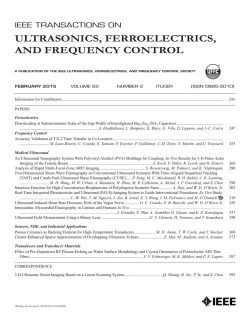
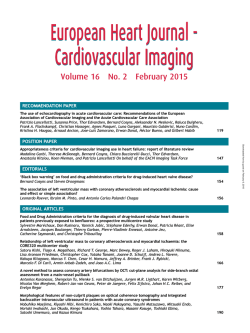
![Download [ PDF ] - journal of evolution of medical and dental sciences](http://s2.esdocs.com/store/data/000475167_1-3fd66abd823a299e32f0bb1f6c6f6a60-250x500.png)
